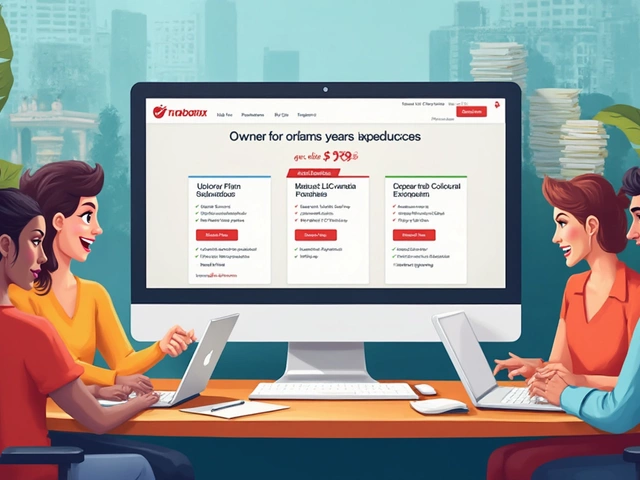If you own a corporation, Form 1120 is the tax return you can't ignore. There's no cute way around it—the IRS expects every C corporation in the U.S. to file one, even if the business didn't turn a profit last year. Suddenly that pile of receipts and QuickBooks reports doesn't feel so cozy, right?
Here's the thing: you can file 1120 yourself. There's no law saying an accountant has to do it for you. Plenty of small business owners handle their own corporate tax filing every year. But this form isn't as user-friendly as a 1040 for personal taxes. It's longer, more detailed, and if you mess it up, penalties aren't pretty.
You need your business financials locked down and be ready to answer questions about gross receipts, cost of goods sold, deductions, and even tricky parts like depreciation or officer compensation. Got everything organized and feel comfortable around tax paperwork? You might be able to save some money and do it yourself—just be honest about your comfort level before jumping in. Nobody wins by winging it with the IRS.
- What Is Form 1120 and Who Needs It?
- What You Need Before You Start
- Can You Realistically File 1120 Yourself?
- Common Mistakes (And How to Dodge Them)
- Tips for Making It Easier
What Is Form 1120 and Who Needs It?
Form 1120 tax form is the IRS form that C corporations use to report their income, gains, losses, deductions, and credits each year. Think of it as the business version of your personal tax return—but much beefier. If your company is a standard corporation (C corp), you absolutely need to file it, no matter how big or small your business is or how much money you made (or lost).
Here's where it gets specific. Only C corporations file Form 1120. S corporations use a different form—1120S—while LLCs, partnerships, and sole proprietors have their own set of forms. If you filed articles of incorporation with your state and haven't elected S corp status, the IRS sees you as a C corp, and Form 1120 is a must every year.
Here are some groups that need to file Form 1120:
- Businesses registered as C corporations (even if inactive or with no income).
- Corporations in their first year, even if just started in December.
- Personal service corporations (companies providing services in fields like health, law, or accounting as C corps).
There are deadlines too—Form 1120 is usually due on the 15th day of the fourth month after your corporation’s fiscal year ends. For most folks who run on a calendar year, that means April 15. Miss the deadline and the IRS can slap you with fines: the penalty is typically $500 per month (up to $6,000) if you don’t file on time—and that's just for being late, not for any back taxes.
| Business Type | Main Tax Form | Who Files? |
|---|---|---|
| C Corporation | 1120 | All standard corporations |
| S Corporation | 1120S | Corporations with S election |
| LLC | 1065 or Schedule C | LLCs (partnership/sole owner) |
| Partnership | 1065 | Two or more owners |
| Sole Proprietor | Schedule C (1040) | Individual owner |
One quirky fact: Even if your corporation had no activity but is still legally active, you still have to file. Forgetting this can trigger annoying IRS letters months later. Bottom line: If you’re a C corp, this form isn’t optional. It's the one tax form you can’t afford to skip.
What You Need Before You Start
Before tackling the 1120 tax form yourself, you’ve got to gather more than just a few numbers on a notepad. This isn’t a guessing game—the IRS expects details, and missing anything could slow you down or even trigger fines. So let’s make sure you have your ducks in a row.
Here’s what you should definitely have at your fingertips:
- Employer Identification Number (EIN): You probably know this already, but your business needs an EIN to file.
- Complete financial records for the tax year: This means your income, expenses, receipts, statements, and any balance sheets. If you use accounting software, export those reports now.
- Last year’s tax return: Even if things are different this year, you’ll save time and avoid errors by referencing it.
- Details of shareholders and ownership: The IRS wants info on who owns what share of the business.
- Documentation for deductions: Office supplies, travel, payroll, rent, interest—basically, if you’re going to deduct it, keep proof.
- W-2s and 1099s issued by your business: The IRS checks these against what your contractors and employees report.
- Records of assets and depreciation schedules: If you’ve got company vehicles, equipment, or property, you’ll need these details. Depreciation is where people mess up the most.
Finger on the pulse time: According to the IRS, nearly 900,000 corporations filed Form 1120 in 2023. Each one needed to have this information lined up, or risk getting their returns kicked back.
| Must-Have Item | Why You Need It |
|---|---|
| EIN | Identifies your business—no EIN, no filing |
| Financial Records | You'll need profit/loss, balance sheets, and bank statements |
| Previous 1120 Return | Keeps things consistent and helps catch errors |
| Shareholder Info | IRS wants names and ownership breakdowns |
| Proof for Deductions | Backup in case of audit |
| W-2s and 1099s | The IRS checks both sides |
| Asset & Depreciation Details | Required for correct depreciation |
Double-check this list before you get started. You’ll save hours—and maybe save yourself from having the IRS blowing up your mailbox later.

Can You Realistically File 1120 Yourself?
Tons of business owners ask themselves this every tax season. So, here’s the honest scoop: yes, you can file the 1120 tax form yourself—but the devil’s in the details. If your corporation has simple finances (think: few transactions, no employees, no inventory headaches), it’s totally doable. There are even decent tax software platforms, like TurboTax Business and H&R Block, with clear walk-throughs made just for the 1120.
But things change once your company grows. Got lots of expenses, complicated deductions, foreign transactions, or shareholders sprawled across several states? DIY gets riskier. One missed form or wrong number on things like credits or carryovers can cost way more than a tax pro’s fee.
Here’s a quick gut check to see if doing it yourself makes sense:
- You understand your business income, expenses, assets, and liabilities.
- Your records are up to date and well organized (bank statements, payroll, receipts).
- Your corporation didn’t change states, merge, or reorganize this year.
- You know how to handle common schedules like Schedule C (dividends), J (tax computation), and K (shareholder info).
- You’re comfortable reading official IRS instructions (Form 1120 comes with over 30 pages of them).
If you’re nodding yes to all these, filing yourself could work out. But if you hit questions or things start to look weird, there’s no shame in calling in an accountant. The IRS doesn’t cut any slack for honest mistakes, and the penalty for a late or incorrect 1120 can snowball fast—up to 5% of the unpaid tax per month.
Bottom line: self-filing is realistic for sharp, organized owners with simple situations. Once things get complex or you’re losing sleep over the forms, it’s worth getting help. Saving a few bucks isn’t worth risking an audit or a nasty fine.
Common Mistakes (And How to Dodge Them)
Filing Form 1120 sounds straightforward, but a lot of business owners trip up on the same headaches. You don’t need to panic—you just need to know where the traps are. Here’s a rundown of the classic blunders and how you can sidestep them.
- Missing deadlines. The due date for Form 1120 is the 15th day of the fourth month after your tax year ends. For most, that means April 15, but if your business has a different fiscal year, it moves. The IRS loves collecting late fees: the penalty is 5% of the unpaid tax for each month it's late, capped at 25%. Mark your calendar.
- Forgetting to report all income. Sometimes business owners think if money didn’t hit their main account, it doesn’t count. Nope. All business income, no matter how it comes in, needs to be on that 1120.
- Mistakes on deductions. This is huge—especially for things like officer compensation and depreciation. Mess these up and you could get audited or miss out on major tax savings. Don’t guess.
- Math errors. Sounds basic, but the IRS says math mistakes are in the top three problems every year. If you’re filling out the form by hand or switching numbers between spreadsheets, double-check every total.
- Not attaching required schedules. If your company claims deductions, reports inventory, or has shareholders, extra forms (like Schedule G or Schedule K-1) often need to go with your return. It’s easy to forget one.
Check out this quick breakdown of how common these mistakes actually are (according to IRS data from the last few years):
| Mistake | % of 1120 Filings |
|---|---|
| Math errors | ~18% |
| Incorrect deductions | ~12% |
| Missed deadlines | ~11% |
| Missing schedules/forms | ~9% |
Dodging these is simpler than you think. Here’s what works for most people:
- Keep all your business records organized, right from the start. Spreadsheets, cloud accounting tools, even old-school folders—whatever keeps things straight.
- Read the Form 1120 instructions before you start. They’re not thrilling, but they’ll help you figure out which extra forms you need.
- Don’t rush. Seriously—most mistakes happen when you’re tired or just want to get it over with.
- If you’re not sure about a deduction or number, check reliable IRS sources or tax guides. Guessing leads to problems.
- Run totals twice. Whether you’re using software or a calculator, a second look can save you from a call from the IRS.
If you take one tip for handling your 1120 tax form, it’s double-checking every step. An hour spent now saves weeks of misery later if you get a nastygram from the IRS.

Tips for Making It Easier
Tackling Form 1120 tax form doesn't have to feel like mountain climbing in flip flops. If you set yourself up right, the job gets a lot smoother. Here’s how to keep your stress level low when handling your corporation’s tax return.
- Get organized before you start. If your bookkeeping is up-to-date and every receipt is where it should be, you'll save hours. Use accounting software that lets you export profit and loss statements, balance sheets, and expense reports—you're going to need all three.
- Use IRS tools. The IRS doesn't hand out gold stars, but they have online guides and Form 1120 instructions that actually help. Check their site for the official PDF and FAQ pages. Their instructions break down every single line so you’re not left guessing.
- Avoid paper filing if you can. E-filing is quicker and gets you instant confirmation. About 70% of corporations e-filed in 2024, according to IRS data. Plus, you can use popular tax software like TurboTax Business, TaxAct, or TaxSlayer—worth considering for error checking and auto-calculations.
- Double check key numbers. One small typo could mean a letter from the IRS, which nobody wants. Pay extra attention to your EIN, gross receipts, and total tax due. If you’re not sure, check previous returns and bank statements.
- Don’t wait until the last minute. If you rush, mistakes happen. It’s easier to fix problems if you spot them with time to spare before the filing deadline (usually April 15 or the 15th day of the fourth month after your fiscal year ends).
Sometimes, a quick gut check helps too. Here’s what the IRS says about filing on your own (straight from their small business resources):
“Corporations are responsible for the accuracy of their returns, even when self-prepared. Use available resources and don’t hesitate to seek help if stuck.”
Not sure about what records to keep? The IRS expects you to keep records for at least three years, but some records—like formation docs or stock ledgers—should be kept forever. Here’s a no-frills look:
| Document | How Long to Keep |
|---|---|
| Tax returns | At least 3 years |
| Receipts | At least 3 years |
| Formation paperwork | Permanently |
| Stock records | Permanently |
If you hit a wall, you can hire a pro just for the tricky part—no shame in that. Sometimes even tax-savvy business owners call for backup when depreciation gets messy or there’s a question about credits. Whatever route you pick, being thorough and giving yourself time will always win out.


